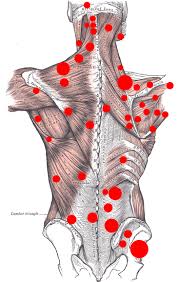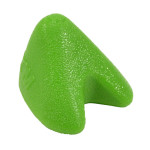The Truth About Trigger Points
We have all heard of trigger points. But what exactly are they? Are they as big of deal as we are led to believe? Let’s take a closer look.
What is trigger point?
A ‘trigger point’ (or myofascial trigger point technically) is defined as a hyper-irritable spot usually within a taut band of skeletal muscle or in the muscle’s fascia. This point is painful on compression and gives rise to referred pain, tenderness, and autonomic reactions (Travell and Simmons, 1983).
It is worth noting that every muscle in our bodies can be subject to chronic strain. Therefore any muscle in our body may develop one of these myofascial trigger points.
Common Trigger Points
There are many ‘common trigger points’ in the body. Below is a diagram depicting some common trigger point sites in the upper body. There are more trigger points typically found in the upper body than lower body.
Why do trigger points develop?
Muscle trigger points tend to develop when the muscle is getting ‘overloaded’. This overload is normally due to the muscle and its surrounding network of muscles or ‘friends’ of any given muscle being weak. When the muscle is weak it gets overloaded. When the muscle gets overloaded it is susceptible to developing tightness and associated trigger points within the muscle.
Treating trigger points
There are two steps required to effectively treat trigger points.
1. Firstly restore the affected muscle to an optimal tension by releasing the tightness that is causing pain and problems. Reproduction of the patient’s pain with pressure on the trigger point is enough to assume that the muscle is at least partially if not fully responsible for the pain pattern of the patient.
2. Secondly to correct the problem and fix it for the longer term the weakness that exists in the muscle and any surrounding muscles that are also affecting the specific muscle that is painful need to be strengthened. A skilled physiotherapist will be able to assess a patient and determine which muscles need strengthening. Specific rehabilitation based exercises can then be prescribed to remedy the muscle weakness.
Releasing the tension
There are several ways to release the tension that exists within a myofascial trigger point. This can be achieved by yourself or by treatment administered from a health professional such as a physiotherapist.
- Therapist releases. Typically a therapist will use treatment techniques that use sustained pressure on the dysfunctional muscle or trigger point region. Pressure may be applied through the fingers or thumbs (known as digital ischemic pressure) or often through use of an elbow! Pressure is generally sustained for 1-2mins per trigger point or until the therapist feels that the muscle tension has ‘let go’ or subsided.
- Dry needling. Dry needling is a Western method of needling whereby a therapist such as a physiotherapist will insert fine needles into the belly of a muscle in order to release tension. The therapist may need to move the ‘pin’ or needle in and out of the muscle at varying angles in order to needle an active trigger point. When the trigger point is found the muscle typically gives a reflexive ‘release’ (like a mini spasm) before relaxing. Dry needling is a wonderful addition to a physiotherapist’s ‘tool box’ of therapy modalities.
- Self -releasing of trigger points. This can be done by using ‘trigger point tools’. There are many available on the market. My favourite is the Pocket Physio* (made by Lockeroom)-see picture below. You simply place the Pocket Physio or whatever trigger point device you have under the trigger point and lean or apply your body weight into it. Hold each trigger point for 30s-1min. The pressure you use should be uncomfortable but not unbearable.
You can watch trigger point releases being performed for the following common trigger points:
1. Shoulder: rotator cuff HERE.
2. Neck (upper traps and levator scapulae muscles) HERE.
3. Between the shoulder blades (the rhomboids) HERE.
Look after yourself and please don’t underestimate the benefits of trigger point releases for your musculo-skeletal and body’s optimal health.
PAIN-FREE. PERFORM. PROLONG
Brad Beer (APAM)
Physiotherapist, Author, Founder POGO.
References
Travell and Simmons, 1983
*Pocket Physios are available from POGO RRP $17.00 or online via the www.lockeroomsports.com.au website.










[…] TrPs, or knots, tightness and soreness in the muscles are part of the body’s pain sensory experience when a chronic pain syndrome develops. It is the musculoskeletal system’s reaction [or nociceptive impulses] which TrP therapy and treatment seeks to alleviate. Though prevention of further TrPs can be better managed with physical therapy techniques, exercise and stretching (ie. Yoga). […]